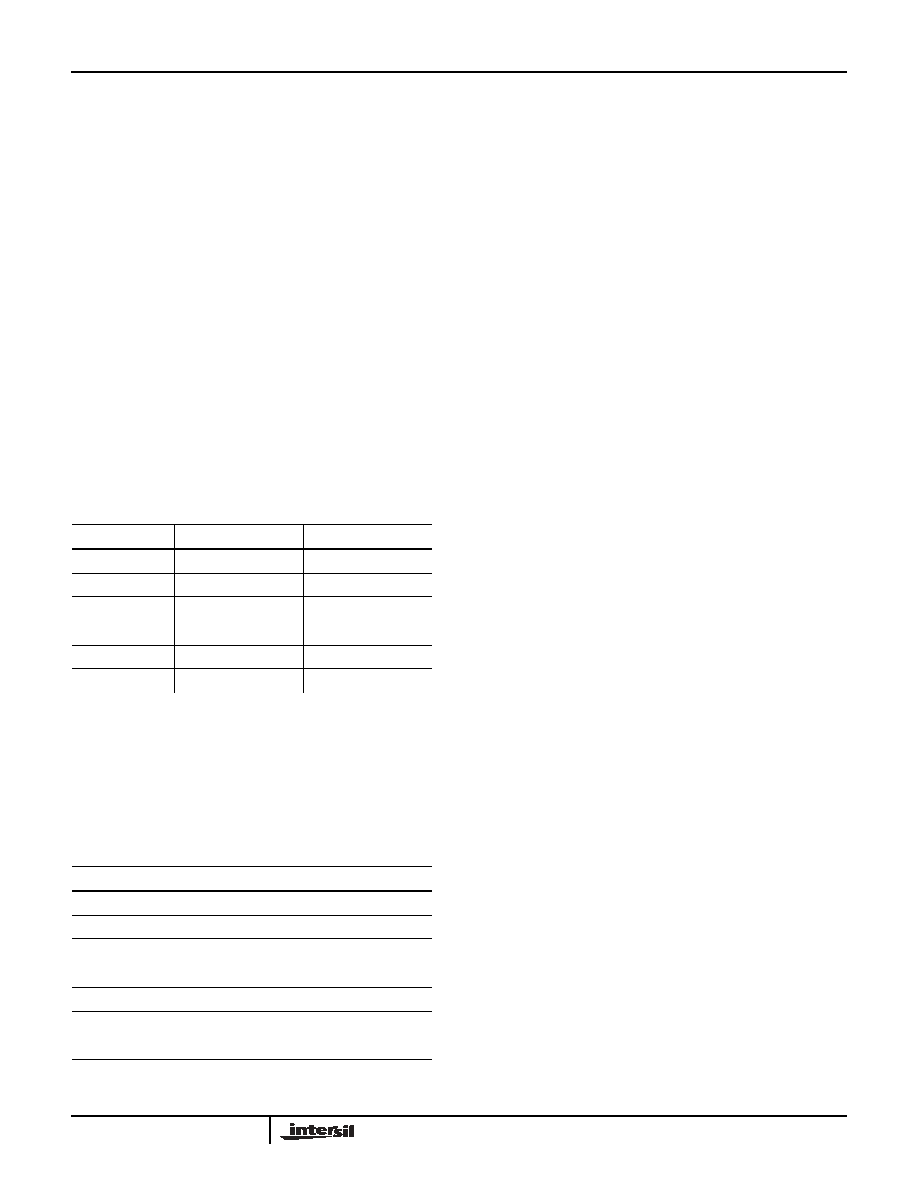参数资料
| 型号: | HFA1100IB96 |
| 厂商: | Intersil |
| 文件页数: | 5/10页 |
| 文件大小: | 0K |
| 描述: | IC OPAMP CFA 850MHZ 8-SOIC |
| 标准包装: | 2,500 |
| 放大器类型: | 电流反馈 |
| 电路数: | 1 |
| 转换速率: | 2300 V/µs |
| -3db带宽: | 850MHz |
| 电流 - 输入偏压: | 25µA |
| 电压 - 输入偏移: | 2000µV |
| 电流 - 电源: | 21mA |
| 电流 - 输出 / 通道: | 60mA |
| 电压 - 电源,单路/双路(±): | 4.5 V ~ 11 V,±2.25 V ~ 5.5 V |
| 工作温度: | -40°C ~ 85°C |
| 安装类型: | 表面贴装 |
| 封装/外壳: | 8-SOIC(0.154",3.90mm 宽) |
| 供应商设备封装: | 8-SOIC |
| 包装: | 带卷 (TR) |

4
FN2945.9
Application Information
Optimum Feedback Resistor (RF)
The enclosed plots of inverting and non-inverting frequency
response detail the performance of the HFA1100 in various
gains. Although the bandwidth dependency on ACL isn’t as
severe as that of a voltage feedback amplifier, there is an
appreciable decrease in bandwidth at higher gains. This
decrease can be minimized by taking advantage of the
current feedback amplifier’s unique relationship between
bandwidth and RF. All current feedback amplifiers require a
feedback resistor, even for unity gain applications, and the
RF, in conjunction with the internal compensation capacitor,
sets the dominant pole of the frequency response. Thus, the
amplifier’s bandwidth is inversely proportional to RF. The
HFA1100 design is optimized for a 510
R
F, at a gain of +1.
Decreasing RF in a unity gain application decreases stability,
resulting in excessive peaking and overshoot (Note:
Capacitive feedback causes the same problems due to the
feedback impedance decrease at higher frequencies). At
higher gains the amplifier is more stable, so RF can be
decreased in a trade-off of stability for bandwidth. The table
below lists recommended RF values for various gains, and the
expected bandwidth.
5V Single Supply Operation
This amplifier operates at single supply voltages down to
4.5V. The table below details the amplifier’s performance
with a single 5V supply. The dramatic supply current
reduction at this operating condition (refer also to Figure 23)
makes these op amps even better choices for low power 5V
systems. Refer to Application Note AN9745 for further
information.
Use of Die in Hybrid Applications
This amplifier is designed with compensation to negate the
package parasitics that typically lead to instabilities. As a
result, the use of die in hybrid applications results in
overcompensated performance due to lower parasitic
capacitances. Reducing RF below the recommended values
for packaged units will solve the problem. For AV = +2 the
recommended starting point is 300
, while unity gain
applications should try 400
.
PC Board Layout
The frequency performance of this amplifier depends a great
deal on the amount of care taken in designing the PC board.
The use of low inductance components such as chip
resistors and chip capacitors is strongly recommended,
while a solid ground plane is a must!
Attention should be given to decoupling the power supplies.
A large value (10
F) tantalum in parallel with a small value
chip (0.1
F) capacitor works well in most cases.
Terminated microstrip signal lines are recommended at the
input and output of the device. Output capacitance, such as
that resulting from an improperly terminated transmission
line will degrade the frequency response of the amplifier and
may cause oscillations. In most cases, the oscillation can be
avoided by placing a resistor in series with the output.
Care must also be taken to minimize the capacitance to ground
seen by the amplifier’s inverting input. The larger this
capacitance, the worse the gain peaking, resulting in pulse
overshoot and possible instability. To this end, it is
recommended that the ground plane be removed under traces
connected to pin 2, and connections to pin 2 should be kept as
short as possible.
An example of a good high frequency layout is the
Evaluation Board shown below.
Evaluation Board
An evaluation board is available for the HFA1100 (Part
Number HFA11XXEVAL). Please contact your local sales
office for information.
ACL
RF ()BW (MHz)
+1
510
850
-1
430
580
+2
360
670
+5
150
520
+10
180
240
+19
270
125
PARAMETER
TYP
Input Common Mode Range
1V to 4V
-3dB BW (AV = +2)
267MHz
Gain Flatness (to 50MHz, AV = +2)
0.05dB
Output Voltage (AV = -1)
1.3V to 3.8V
Slew Rate (AV = +2)
475V/
s
0.1% Settling Time
17ns
Supply Current
5.5mA
HFA1100
相关PDF资料 |
PDF描述 |
|---|---|
| LTC2055IDD#PBF | IC OPAMP ZERO DRIFT DUAL LP 8DFN |
| 950480-6102-AR | CONN SOCKET 80POS 2MM VERT T/H |
| LTC2055IDD | IC OPAMP ZERO DRIFT DUAL LP 8DFN |
| HA9P5320-5 | IC AMP SAMPLE&HOLD 2MHZ 16-SOIC |
| LTC2055HDD#PBF | IC OPAMP ZERO DRIFT DUAL LP 8DFN |
相关代理商/技术参数 |
参数描述 |
|---|---|
| HFA1100IBZ | 功能描述:运算放大器 - 运放 OPAMP 850MHZ CFB IND RoHS:否 制造商:STMicroelectronics 通道数量:4 共模抑制比(最小值):63 dB 输入补偿电压:1 mV 输入偏流(最大值):10 pA 工作电源电压:2.7 V to 5.5 V 安装风格:SMD/SMT 封装 / 箱体:QFN-16 转换速度:0.89 V/us 关闭:No 输出电流:55 mA 最大工作温度:+ 125 C 封装:Reel |
| HFA1100IBZ96 | 功能描述:运算放大器 - 运放 OPAMP 850MHZ CFB IND RoHS:否 制造商:STMicroelectronics 通道数量:4 共模抑制比(最小值):63 dB 输入补偿电压:1 mV 输入偏流(最大值):10 pA 工作电源电压:2.7 V to 5.5 V 安装风格:SMD/SMT 封装 / 箱体:QFN-16 转换速度:0.89 V/us 关闭:No 输出电流:55 mA 最大工作温度:+ 125 C 封装:Reel |
| HFA1100IJ | 制造商:Rochester Electronics LLC 功能描述:ULTRA HIGH SPEED CURRENT FEEDBACK OP AMP, 8 PIN CDIP - Bulk |
| HFA1100IP | 功能描述:IC OP AMP 850MHZ CFB 8-PDIP RoHS:否 类别:集成电路 (IC) >> Linear - Amplifiers - Instrumentation 系列:- 标准包装:50 系列:- 放大器类型:通用 电路数:2 输出类型:满摆幅 转换速率:1.8 V/µs 增益带宽积:6.5MHz -3db带宽:4.5MHz 电流 - 输入偏压:5nA 电压 - 输入偏移:100µV 电流 - 电源:65µA 电流 - 输出 / 通道:35mA 电压 - 电源,单路/双路(±):1.8 V ~ 5.25 V,±0.9 V ~ 2.625 V 工作温度:-40°C ~ 85°C 安装类型:表面贴装 封装/外壳:10-TFSOP,10-MSOP(0.118",3.00mm 宽) 供应商设备封装:10-MSOP 包装:管件 |
| HFA1100MJ/883 | 制造商:INTERSIL 制造商全称:Intersil Corporation 功能描述:850MHz Current Feedback Amplifier |
发布紧急采购,3分钟左右您将得到回复。